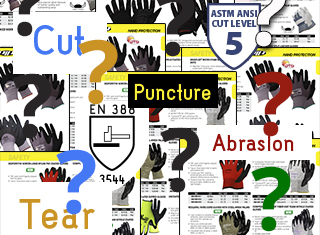
03 Mar So Many Gloves, So Little Information
There are hundreds of different work glove models available today, and even the pros are sometimes at a loss to explain the relative merits of one nitrile coated glove over the one next to it in the catalog. It’s the same feeling I get when I’m standing in front of display of energy drinks. They all have colorful labels, but I have no idea which one is going to do the best job of giving me the boost I’m looking for without putting my health at risk.
Don’t get me wrong—I’m not complaining about too many choices. But with an abundance of choices, it is incumbent on suppliers to distinguish the differences between them for consumers. The information available from manufacturer’s literature and distributor’s catalogs is often scant or confusing. Progress is being made, but much more is needed.
Cut level is just one of many metrics
In response to the demands of certain users, information on cut resistance is now widely available on many gloves. This is a step in the right direction, but is cut resistance the only measurable metric of a glove? Is it the only one that matters enough to furnish the test results?
For those whose work involves saws, knives or other slicing hazards, knowing which glove offers the best cut resistance is indeed critical information. But what about users who don’t work around cut hazards? Cut resistance is not a useful metric to the user who is mainly concerned about preventing blisters and scratches. Do your workers replace their gloves more often because something sliced through them, or because they wore a hole in the fingers or palms? What about risk of puncture from a splinter or a dirty needle? If you think cut level ratings correlate with puncture resistance, you are in good company—but it is my sad duty to inform you that you and your companions are mistaken. Some of the better puncture resistant gloves test poorly for cut resistance, and vice versa.
Blisters and scrapes are abrasion-based hazards, and there are tests designed to measure a glove’s resistance to those forces. Yet abrasion resistance test results are not included in very many glove descriptions out there.
Comparison at a glance
As domestic PPE suppliers grapple with the task of disseminating useful information about the gloves we sell, one can’t help but envy the simple system already in use in other parts of the world. You may have noticed a distinctive hammer-within-a-shield stamp on some of the gloves you use. This is the symbol for the European Committee for Standardization’s EN 388 standard, and the stamp must appear on every work glove sold in the EU. The label, which appears on many (but, alas, not all) gloves sold in the U.S., shows the EN 388 icon and a number grade for that glove in each of four categories. The categories are Abrasion Resistance, Cut Resistance, Tear Resistance and Puncture Resistance. The grades are derived by subjecting the glove to standardized tests in each category.
The advantage of this label is immediately apparent when comparing two or more gloves that bear it: You will know at a glance which glove does the better job in the areas that matter most to you.
For all its utility, the EN 388 label does not address every measurable parameter of interest to every glove user. ANSI/ISEA 105 offers additional testing standards for such things as heat and flame protection, among other things, as well as proposed standards for vibration protection and dexterity. Whether the EN 388 label is ultimately embraced by domestic distributors and manufacturers, or a competing system based on ANSI-style criteria becomes the norm, it’s only a matter of time before a more comprehensive grading system becomes the coin of the realm for work gloves in the U.S.
In the mean time, your glove supplier can be an invaluable resource in helping you determine what to look for in a glove for the tasks that your users perform.



No Comments